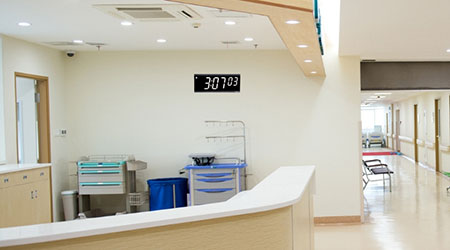Power over Ethernet (PoE) has emerged as a top technology aiding hospitals and healthcare facilities in rolling out high performance IT solutions, while cutting energy usage and costs. PoE is the standard accepted by the Institute of Electrical and Electronic Engineers (IEEE) enabling power and data to be routed to a device using a single RJ-45 connection.
Common PoE applications include Wi-Fi access points, IP surveillance cameras, and door access systems. Synchronized wall clocks also join the ranks of PoE-enabled devices, receiving their power and time signal using the IEEE802.3af standard. For facilities rich in Ethernet infrastructure, achieving a perfectly synchronized clock system could not get any easier than simply plugging in a CAT5/6 cable.
Installation
Sites equipped with a PoE-enabled network are already compatible with a PoE/IP Network Synchronized Clock System. For new builds or renovation projects, cabling provisions may be addressed during construction. Consider patient rooms, emergency rooms, operating rooms, meeting rooms, stations, departments, or any area where a highly visible synchronized time source is required.
A Power over Ethernet clock continuously receives power and NTP time data over a single Ethernet cable directly connected to your PoE-enabled port on your hub/switch. Usually located in a facility’s server room, one standard PoE hub/switch is able to support up to 48 clocks. An unlimited number of clocks can be supported by adding PoE switches. Once the clocks are connected, they will automatically request and receive power.
Flexibility and scalability
PoE connectivity permits long runs of cable (up to 300 feet), that can be routed anywhere throughout a facility. Without being tethered to an electrical outlet or hard wiring, PoE clocks allow greater design flexibility. This type of system provides the ability to mount clocks in areas where conventionally-powered devices are prohibitive due to cable length limitations, or in spaces where electrical wiring and outlets are impractical, such as drop ceilings.
The scalability of a PoE clock system is much greater than that of a conventional systems and allows for a simple, inexpensive installation. Simply add or relocate clocks to any location on the network via RJ-45 connection.
Synchronization
Accurate time is critical in healthcare facilities. Efficient patient throughput, standardized schedules, timely medication disbursement, accurate medical record maintenance, and Joint Commission compliance rely on precisely synchronized time from the emergency room to the patient's room.
PoE clocks receive time directly from your network, therefore each clock displays the same exact time, eliminating time discrepancies and inconsistency. Many PoE models also feature customizable Daylight Saving Time, 12/24 hour time modes (digital displays), and time zone offset. The use of a single, secure network infrastructure, facilitates the seamless deployment, maintenance, and control of every clock on the system.
Compared to RF wireless clocks, PoE clocks are inherently less susceptible to time data disruptions, such as radio wave interference, physical barriers, or bandwith limitations. A PoE clock system ensures a reliable time source, since both power and data originate from a central source.
A PoE Synchronized Clock System ensures accurate time is displayed consistently throughout your healthcare facility. Display formats range from traditional analog clocks to easy-to-read LED digital clocks, visible for up to 250 feet away.
Cost savings
Since PoE enables electrical power to be passed through Ethernet cables instead of standard electrical wiring, the need for specialized electrical personnel to install conduit, electrical wiring or outlets is eliminated. There is no additional equipment necessary, such as transmitters, master clocks, or circuit breakers. The safe, low voltage PoE clock system only requires a technician to run one Ethernet cable per clock to an access point.
Another major benefit of PoE-enabled devices is the cost savings associated with lower power consumption. PoE clocks are characterized by 48VDC input, and use up to 50% less power than standard electrical clocks. Over time, the savings throughout an entire facility are surmountable.
Keeping accurate and consistent time throughout a large or small healthcare facility is easy with PoE/IP Network wall clocks. PoE synchronized clocks are a simple, low maintenance, cost effective, dependable clock system, ideal for new construction or renovation projects in the healthcare industry.
Jennifer S. Altschuler is the Marketing Manager for Pyramid Time Systems, LLC.

 UF Health Hospitals Rely on Green Globes to Realize Their Full Potential
UF Health Hospitals Rely on Green Globes to Realize Their Full Potential How Healthcare Facilities Can Be Truly Disaster-Resilient
How Healthcare Facilities Can Be Truly Disaster-Resilient TriasMD Breaks Ground on DISC Surgery Center for San Fernando Valley
TriasMD Breaks Ground on DISC Surgery Center for San Fernando Valley Bigfork Valley Hospital Falls Victim to Data Breach
Bigfork Valley Hospital Falls Victim to Data Breach AI-Driven Facilities: Strategic Planning and Cost Management
AI-Driven Facilities: Strategic Planning and Cost Management